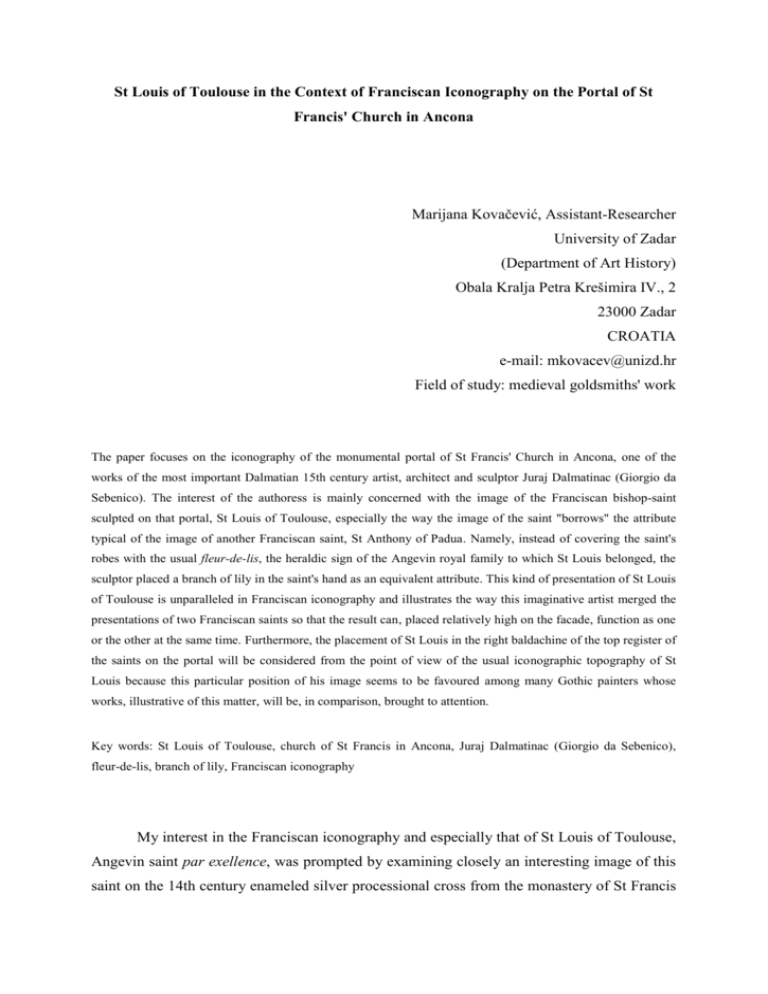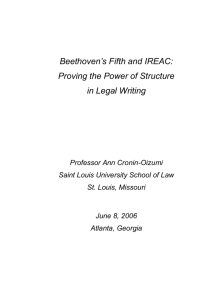St Louis of Toulouse and the Franciscan Iconography on the Portal
advertisement

St Louis of Toulouse in the Context of Franciscan Iconography on the Portal of St Francis' Church in Ancona Marijana Kovačević, Assistant-Researcher University of Zadar (Department of Art History) Obala Kralja Petra Krešimira IV., 2 23000 Zadar CROATIA e-mail: mkovacev@unizd.hr Field of study: medieval goldsmiths' work The paper focuses on the iconography of the monumental portal of St Francis' Church in Ancona, one of the works of the most important Dalmatian 15th century artist, architect and sculptor Juraj Dalmatinac (Giorgio da Sebenico). The interest of the authoress is mainly concerned with the image of the Franciscan bishop-saint sculpted on that portal, St Louis of Toulouse, especially the way the image of the saint "borrows" the attribute typical of the image of another Franciscan saint, St Anthony of Padua. Namely, instead of covering the saint's robes with the usual fleur-de-lis, the heraldic sign of the Angevin royal family to which St Louis belonged, the sculptor placed a branch of lily in the saint's hand as an equivalent attribute. This kind of presentation of St Louis of Toulouse is unparalleled in Franciscan iconography and illustrates the way this imaginative artist merged the presentations of two Franciscan saints so that the result can, placed relatively high on the facade, function as one or the other at the same time. Furthermore, the placement of St Louis in the right baldachine of the top register of the saints on the portal will be considered from the point of view of the usual iconographic topography of St Louis because this particular position of his image seems to be favoured among many Gothic painters whose works, illustrative of this matter, will be, in comparison, brought to attention. Key words: St Louis of Toulouse, church of St Francis in Ancona, Juraj Dalmatinac (Giorgio da Sebenico), fleur-de-lis, branch of lily, Franciscan iconography My interest in the Franciscan iconography and especially that of St Louis of Toulouse, Angevin saint par exellence, was prompted by examining closely an interesting image of this saint on the 14th century enameled silver processional cross from the monastery of St Francis in Zadar, which will be mentioned again in the following text. The main topic of this article is the iconography of the ornate portal of the church of St Francis in Ancona, popularly called San Francesco alle Scale. Its etimology can be guessed by looking at the elevated position the church occupies in the urban scheme of this Adriatic town, the plateau reached by many steps (scale), which also contributes significantly to the scenic quality of the portal. The portal is one of the most important works of Juraj Dalmatinac, or Giorgio da Sebenico (Giorgio Orsini), as Italian art historians tend to call one of the greatest Croatian artists of all times, who worked in many Adriatic towns, but who became renowned mostly for his work on the cathedral of Šibenik.1 Professor Igor Fisković wrote a thorough study of Juraj's opus in Ancona2 back in 1984. and since then there were no other significant developments of the analysis of any Juraj's work in that town. The aforementioned portal is the second of Juraj's three works in Ancona, and it was begun in 1452 at the latest. Namely, that year in Šibenik he made a contract with Ivan Pribislavljić, an artist from his workshop. According to the text of that contract Ivan was supposed to make many parts of the portal in Ancona and according to the further contracts the making of this portal lasted the whole decade. A year earlier, in 1451, Juraj had started to work on his first work in Ancona, the so called Loggia dei Mercanti, and for this ornate facade he had another helper from his workshop - Andrija Aleši. Finally, in 1460., Juraj participated in the contract with the Augustinian friars in Ancona who wanted him to make a portal for their church which was supposed to be as wide as that on the facade of San Francesco alle Scale.3 Juraj's most important work is the cathedral of the Dalmatian town Šibenik where he started working in 1441. and whereto he moved back from Venice with his family. We know nothing about his life or work in Venice except that he lived there with his family and had a house, but it is believed that he was that Schiavone mentioned by Filarete who did some important works in Venice. The documents confirm that he was actually born in Zadar, probably shortly after the begining of the 15th century, where he also worked in the forties of the 15th century. The other places where he or his workshop worked include Dubrovnik, Split, Pag, Rab and Ancona where he left his works, but he also worked in Rimini and Ravenna, where none of his works have been identified to the present. His workshop in Šibenik was big and busy. There he continued building the cathedral in 1441 that was begun a decade earlier. He was responsible for the concept and the building of the eastern part of the cathedral, up to the dome that was finished after his death. The apses were begun in 1443 as confirmed by the inscription held by two angels below whose feet Juraj left his signature - hoc opus cuvarum fecit magister Georgius Mathaei Dalmaticus. The baptistery was also finished that year, but this church remained his main task for the next three decades and yet was left unfinished at the time of his death in the early seventies.4 Although my interest in Juraj's work for the Franciscan church in Ancona primarily concerns its iconography, it should be noted that the artist's strong personal style based on Venetian gotico fiorito, as can also be seen on Juraj's characteristic foliate decoration of two friezes of leafs heading in the opposite directions, was learned probably in the Venetian workshop of Giovanni and Bartolomeo Buon. It is believed that Juraj was their helper on the Porta della Carta in Venice5 and one look at this monumental Venetian portal (fig. 03) immediately overlaps with the concept, composition and the emphasized verticality of the Franciscan portal in Ancona,6 while two "putti" holding inscription from Šibenik cathedral also find their counterparts on the Porta della Carta. Still, what made Juraj's style fresh and individual are the Tuscan inovations concerning perspective, building techniques and also a breeze of humanism on the faces of his sculptures whose bodies were often still curved in the tipically Gothic S lines. That is why his role in Croatian art is that of, in a figure of speech, opening the door for the reception of Renaissance in architecture and sculpture. Back to the Franciscan portal in Ancona, let us first say a few words about its iconography. In the lunette, there is Stigmatization od St Francis (fig. 4) which is considered to definitely be a work of Ivan Pribislavljić based on documented data and on comparison with his work in Šibenik, especially the relief in the church of St John in Šibenik representing St John among the members of the Confraternity of St John. But the frieze of heads placed around the door, baldachin top part of the portal and the foliate decoration strongly remind us on Juraj's works in Šibenik and Split. The most voluminous sculptures of the portal are the statues of the Franciscan saints under the four baldachins. Under the two lower ones there are St Clare (fig. 5) and St Bernardino of Siena (fig. 6), and above them there are St Anthony of Padua, holding a book as one of his usual attributes (fig. 7) and to the right St Louis of Toulouse holding a branch of lily (fig. 8), an attribute that is more often seen in the hands of St Anthony of Padua. Very similar concept was used by Juraj for the Augustinian portal in Ancona (fig. 8), as he placed the narrative scene with the patron of the church as the main protagonist in the lunette with the addition of the Annunciation in the arch below, then the female saint - St Monica in the bottom left baldachine, St Nicholas of Tolentino in the bottom right one, St Simplicianus in the top left baldachine, and St Augustino Triomphi in the top right one. This way there are two friars, a female saint and a bishop-saint similarly distributed on each of the two Juraj's portals in Ancona. Before I turn to the analysis of Juraj's iconography of St Louis, I will present an abridged catalogue of the images of this saint in European, mostly Italian art of the 14th and the 15th centuries, some of which could have been known to Juraj. Although that catalogue will be far from complete, hopefully it will be illustrative. In that catalogue, most of the examples emphasized in the article of professor Julian Gardner from the University of Warwick, on the iconography of St Louis will not be included in order to avoid unecessary repetition. Gardner's article was an efficient guide in the proccess of collecting, organizing and understanding the exemplary material.7 The author noticed that the catalogue of images of St Louis is "notably meagre" when it comes to Italian art. Also, he pointed out that it is "almost wholy restricted to isolated images" because his figure usually appears on the "great high altarpieces of prominent Franciscan churches as his cult coincides almost exactly with the rise of the compartmentalized gothic polyptichs which began to occupy the ever wider altars of Italian churches." There St Louis appears in prominent, if still subordinate positions.8 The pioneer works when it comes to St Louis' iconography are found in the opus of Simone Martini. The most popular of these is the altarpiece representing in its upper part St Louis of Toulouse crowning his brother Robert of Anjou, and in the predela the narrative episodes of his hagiography. Simone Martini probably painted it shortly after the canonization od St Louis in 1317.9 The main and lasting characteristics of the iconography of this saint can be found already in this image - he is a youthful man without a beard, dressed in a combination of Franciscan habit and episcopal garb, with the crosier in hand and the mitre covering his head. We can also see that the Angevin heraldic lilies are scattered all over ste saints' clothes. A few years older image of St Louis was painted by Simone on a fresco painting of the chapel dedicated to St Martin in the church of St Francis in Assisi. It was commissioned im 1312 by the Franciscan cardinal Gentile Partino da Montefiore, who was related to the Angevin royal family.10 The saint is here represented next to another royal saint in his family, St Louis of France, and is dressed only in his Franciscan garb, while his episcopal honour is indicated solely by the crosier and the identifying inscription below his figure. Angevin fleur-de-lis is here scattered on the blue background behind both of the saintly figures. In the images of St Louis of Toulouse created after his canonization in 1317 he will almost regularly be dressed in the episcopal garb underneath which will occasionally be visible also the Franciscan habit. Occasionally a crown is used as another saint's attribute and usually placed by St Louis' feet. Similarly, the figures of the patrons can sometimes also be found by the saint's feet, and in most such cases there is a political background to their appearance. Generally, it seems that the comparison of the images of St Louis of Toulouse on the 14th and 15th century paintings, sculptures or goldsmiths' works emphasizes how minimally his iconography transformed over the time. The chosen exemplary material from the 14th century consists of the following images of St Louis of Toulouse: the saint's image on Tino da Camaino's tomb of Mary of Anjou in Santa Maria Donnaregina in Naples,11 on another Anjou tomb in Santa Chiara in Naples,12 on the lintel of the main portal of the church San Lorenzo in Vicenza,13 another sculpture of the saint is in the church San Francesco della Vigna in Venezia,14 his image is also on a painting in the Musée Granet in Aix-en-Provence,15 there is one on the polyptich by Jacobello di Bonomo in Sant' Arcangelo di Romagna (Municipio),16 one in the bottom register of the Giovanni Baronzio's "altarolo" with the scene of Crucifixion in the upper section,17 and, finally, St Louis' image is also on Baronzio's polyptich in the church of St Francis in Mercatello.18 In the goldsmiths' work of the 14th century the image of St Louis of Toulouse can be found on a few enameled plaques of Sienese artists. One of them is a part of the altar cross from San Lorenzo in Naples, now in the parish church in Santa Vittoria in Matenano (Ascoli Piceno), on which there is also the image of the patron of the cross, bishop Guglielmus di Salone, who was related to the Angevin dinasty.19 Another Sienese cross with the enameled image of St Louis of Toulouse is treasured in the Louvre Museum in Paris.20 Two other plaques are on the two chalices, one in the British Museum in London signed by Tondino di Guerino and Andrea Riguardi and the other in The Cloisters Collection of The Metropolitan Museum of Art in New York.21 One more image of the saint is on the enameled medallion in Museo della Biblioteca Apostolica Vaticana in Vatican.22 The 15th century examples of St Louis' image can be found on a painting by an anonymous Spanish painter from the treasury of the Bordeaux cathedral,23 on the Michele Giambono's polyptich in the Accademia Galleries in Venice,24 and on the Lodovico Urbani's painting in Museo diocesano in Recanati.25 The images of St Louis can be found on a few paintings of Crivelli brothers, for example on Vittore Crivelli's polyptich in Sant' Elpidio al Mare (Municipio, Sala Consiliare),26 on another polyptich in Pinacoteca Comunale in San Severino,27 also on his polyptich in Philadelphia Museum of Art (Wilstach Collection),28 and on the polyptich in Fitzwilliam Museum in Cambridge.29 In the opus of Carlo Crivelli the image of St Louis can be found on the polyptich from the church of St Lucy in Montefiore dell' Aso30 and on his sacra conversazione from Berlin.31 St Louis is also represented on a few paintings by Antonio Vivarini, for example on his polyptich from Pesaro, now in Pinacoteca Vaticana in Rome,32 his polyptich in San Francesco della Vigna in Venice33 and also on his painting in Musée du Petit Palais in Avignon.34 By most of the emphasized examples, a few other remarks asserted by Gardner are confirmed. Primarily, that "the new Angevin saint entered the Franciscan pantheon, but rarely existed independently. When he did, it was generally as a small-scale devotional image like the gold statuette made for Mary of Hungary, or for specifically political reasons, as for example the great gilt bronze figure by Donatello in the niche of the Parte Guelfa on Orsanmichele"35 which will be mentioned again later. Secondly, it is confirmed once again that in the 13th and 14th centuries monumental statues of mendicant saints were decidedly uncommon.36 Gardner also pointed out that the image of St Louis of Toulouse was the most politicized religious image of the Trecento37 which is usually exemplified by the motivation of the identified patrons painted right next to the saint's figure. What had not been emphasized by Gardner is that on most of the paintings where the figure of St Louis can be found his image was placed to the extreme right, either in the lower or the upper register of the saints flanking the central figures or scenes. However, the author did notice that on the high altarpiece of Santa Croce in Florence the panel depicting St Louis of Toulouse was set to the right of the central Virgin and Child.38 The position of St Louis to the extreme right is often to be found in the examples from Croatian art which will also be discussed in this article and Juraj's portal of the Franciscan church in Ancona is one of them. Perhaps this can be explained by the possibility that the iconographical topography of St Louis was adjusted to some older and respected prototype, perhaps the already mentioned altarpiece from Santa Croce. In the attempt to assert Juraj's iconographical originality and inovative artistic spirit, there are two key notions. One of them is the comparison of his iconographical interpretation of St Louis of Toulouse with all the images of this saint in Croatian art of the 14th and the first half of the 15th century and the other is the comparison with the images of St Louis in the 15th century sculpture of Venice, Veneto and Tuscany. The artistic material offered by these two topics is again meagre, but emphasizes further Juraj's freedom and his power of improvization. The only two images of St Louis of Toulouse in Croatian art of the 14th century are found on the wooden choir stalls (fig. 10) and on the already mentioned enameled silver processional cross from the monastery of St Francis in Zadar (fig. 11). The monastery is a place of great historical importance because in its sacristy one of the greatest medieval rulers, as his nickname confirms, Hungarian-Angevin king Louis the Great, signed the famous document called Peace of Zadar in 1358 by means of which Venetian Republic promised to give up Zadar and Dalmatia forever, which turned out to mean only for a little bit more than fifty years, since in 1409 Venice bought Zadar and Dalmatia back for a shameful sum of hundred thousand ducats.39 On both stalls and the cross, St Louis' image appears in a rather uninventive shape - dressed in a combination of Franciscan habit and episcopal garb, with the crosier in hand and the mitre covering his head. Because of the bigger dimensions and the better state of conservation of the stalls as compared to the cross which was stolen in 1974 never to be found, we can also see that the Angevin heraldic lilies are scattered all over the saints' dress and that his face is youtful and without a beard. The images of the patrons with St Louis on both the cross and the stalls uncovers the political background of the appearance of Louis' figure on these pieces of art and again exemplifies the statement of Julian Gardner already quoted in this text that the image of St Louis of Toulouse in the 14th century often had political impact. This is particularly striking on the cross where most of the local patron saints are also represented, but the patroness of the cross still chose to be depicted kneeling by the figure of St Louis.40 In the early 15th century art of Croatia the image of St Louis of Toulouse, except on Juraj's portal in Ancona, can only be found on a painting of the Italian painter Ivan Petrov (Giovanni di Pietro) from Milan, who lived and worked in Dalmatia. Here also, and the painting is now in the State Hermitage Museum in St. Petersburg,41 St Louis was depicted with his usual attributes. In the 6th decade of the 15th century, when the portal in Ancona was being sculpted, Antonio and Bartolomeo Vivarini painted the polyptich (1458) for the main altar of the church of St Euphemia in the Franciscan monastery in Kampor on the island of Rab.42 The polyptich is very similar to the aforementioned Vivarini polyptich from Rome, and St Louis is on both polyptichs in the same position - in the upper register of the saints to the right. The image of the saint on the polyptich from Rab is again tipical (fig. 12). Also, a figure of St Louis can be found on a work of a Croatian painter who worked in the workshop of Francesco Squarcione in the late fifties - Juraj Ćulinović (Giorgio Schiavone as he signed his paintings). One of those signed ones is in Berlin, but it once stood as a central panel of a polyptich on one of the altars in the church of St Francis' in Padua and a wing of that polyptich with the figures of St Louis and St Anthony of Padua is today in Museo Diocesano in Padua.43 Again there are no surprises as far as the iconography of St Louis is concerned and he is depicted with his usual attributes with the addition of a book, and St Anthony with his a branch of lily and a book. In Italian art of the first half of the 15th century there are three significant sculptures of St Louis of Toulouse that are known to me. The image of this saint declined in popularity and prominence and in the Quattrocento it was eclipsed even on Franciscan altarpieces by that of Bernardino or, occasionaly, Bonaventura. It seems that only a personal devotion can be held responsible for its survival. This is the case in Venice where a devotion of a noblewoman 44 resulted in commissioning a sculpture of St Louis which is now in the lunette of the church that shares the saints' name - San Alvise. This sculpture dated in the early 15th century is very damaged but still it is clear that the saints' image was standard, only seated. Wolfgang Wolters saw Tuscan influences on this sculpture, while Anne Markham Schultz attributed it to Bartolomeo Buon.45 More famous are the two images of St Louis by Donatello. The best known is the one I have already mentioned in this article, the bronze statue from the niche on Orsanmichele in Florence, now in Museo di Santa Croce in Florence.46 This figure is again in the usual dress and with the usual attributes, while the Angevin heraldry is constricted to the mitre. Another bronze figure of this saint was made by Donatello for the high altar of the Basilica del Santo in Padua where the Angevin lilies are again on the mitre.47 To sum it up, all three mentioned sculptures show no iconographical invention as far as the attributes are concerned. That is why it is so surprising that Juraj in Ancona put a branch of lily in St Louis' hand which is expected to be St Anthony's attribute, like it is with Donatello's St Anthony on the high altar in the Santo,48 St Anthony on the Vivarini polyptich on Rab (fig. 13) or, for example, with St Anthony on the reliquary of the Precious Blood of Christ in the Venetian Frari Basilica, made in 1485 by the goldsmith Evanđelista Vidulić from Zadar49 (fig. 14), to mention just a few. Igor Fisković noticed that Juraj did not follow the models set by Donatello as far as the iconography is concerned, and also that the sculpture of St Louis of Toulouse in Ancona did not completely fit with the other three on the portal - it has a diferently shaped base and it does not turn inwards like the others.50 This morphological quality is much less interesting than the iconographical invention of a branch of lily in the saint's hand. The most logical explanation for this practice seems to be the extreme hight on which the figure was planed to be placed, a hight that makes it imposible for a viewer to see the Angevin heraldry that is usually scattered all over the bishop's garb or on the mitre, and on Juraj's St Louis exclusively on the mitre. Therefore Juraj accomodated iconographically to the given circumstances. The portal of the Augustinian church shows, in the lunette, how he was able to do that morphologically as well - he adjusted the shaping of the figures to the most likely wiewpoint. Looking at it from the same level, the figures seem rather clumsy, while from below they are proportionate and harmonious. In conclusion, it sems that this kind of presentation of St Louis of Toulouse is unparalleled in Franciscan iconography and illustrates the way this imaginative artist merged the presentations of two Franciscan saints so that the result can, placed relatively high on the facade, function as one or the other at the same time. Perhaps this practice was supposed to simbolyze Franciscan unity, but, bearing in mind Juraj's individuality, I strongly believe that this innovation was due to the imaginative capacity of the artist himself. However, that is only one of the reasons why I believe that a sort of provintial position of Ancona compared to that of Venice is a reason why this work did not achieve the popularity and the international attention of art historians it surely deserved. 1 The list of publications about Juraj Dalmatinac and his opus is rather long and the last bibliography was published back in 1976. (See: J. A. SOLDO, Bibliografija radova o Jurju Dalmatincu, in: Radovi Centra JAZU u Zadru, 22-23, Zadar, 1976) Since then there were many relevant studies published, but still the most complete and most influential study of Juraj's opus remains to be the monograph that Cvito Fisković published almost five decades ago. (C. FISKOVIĆ, Juraj Dalmatinac, Zagreb, 1963, pp. 7-38.) 2 I. FISKOVIĆ, Juraj Dalmatinac u Anconi, in: Peristil, 27-28, Zagreb, 1984-85, pp. 93-146. 3 Op. cit., pp. 95-96. 4 C. FISKOVIĆ, Juraj Dalmatinac, Zagreb, 1963, pp. 7-38.; Enciklopedija hrvatske umjetnosti, 1, Zagreb, 1995, pp. 389-392. 5 W. WOLTERS, La scultura veneziana gotica 1300-1460 (volume primo, testo e catalogo), Venezia, 1976, pp. 281-284. 6 I. FISKOVIĆ, Juraj Dalmatinac u Anconi, in: Peristil, 27-28, Zagreb, 1984-85, p. 138. 7 J. GARDNER, The Cult of a Fourteenth-Century Saint: The Iconography of Louis of Toulouse, in: Patrons, Painters and Saints, Studies in Medieval Italian Painting, Aldershot Hampshire, 1993, pp. 169-193. 8 Op. cit., pp. 173, 191. 9 M. PIERINI, Simone Martini, Milano, 2000, 25, 96-99. 10 Op. cit., Simone Martini, Milano, 2000, 24, 72, 90, 91, 92, 93. 11 L´ Europe des Anjou, Aventure des princes angevins du XIIIe au XVe siècle (exhibition catalogue), Paris, 2001, p. 80. 12 Op. cit., p. 82. 13 W. WOLTERS, La scultura veneziana gotica 1300-1460 (volume primo, testo e catalogo), Venezia, 1976., pp. 167-168.; S. SPONZA, Pittura e scultura a Venezia nel Trecento: divergenze e convergenze, in: La pittura nel Veneto, Il Trecento, Tomo secondo, Milano, 1992, pp. 425, 427. 14 W. WOLTERS, La scultura veneziana gotica 1300-1460 (volume primo, testo e catalogo), Venezia, 1976, p. 202. 15 L´ Europe des Anjou, Aventure des princes angevins du XIIIe au XVe siècle (exhibition catalogue), Paris, 2001, p. 116. 16 F. D'ARCAIS, Venezia (Pittura nel territorio), in: La pittura nel Veneto, Il Trecento, Tomo primo, Milano, 1992, pp. 74, 82. 17 Giovanni Baronzio e la pittura a Rimini nel Trecento (edited by D. FERRARA), Milano, 2008, pp. 96-97. The saint is flanked by four others, while a small figure of a patron, who is obviously also a bishop, is kneeling by his feet. The patron was most probably of French origin, the bishop of Ravenna Aimerico di Châtelus, which additionaly clarifies why he chose to be depicted kneeling by the feet of a bishop-saint who is a descendant of the French royal family. This is another positive comfirmation of the Gardner's remark on the political significance of the appearance of St Louis of Toulouse in the Italian 14th century painting. (J. GARDNER, The Cult of a Fourteenth-Century Saint: The Iconography of Louis of Toulouse, in: Patrons, Painters and Saints, Studies in Medieval Italian Painting, Aldershot Hampshire, 1993, p. 180.). 18 P. ZAMPETTI, Pittura nelle Marche, Vol. 1 (Dalle origini al primo Rinascimento), Firenze, 1988, p. 115., fig. 142. 19 E. CIONI, Scultura e Smalto nell’Oreficeria Senese dei secoli XIII e XIV, Firenze, 1998, pp. 313328, 330-332, 355; M. KOVAČEVIĆ, O prikazima sv. Ludovika u zadarskoj umjetnosti anžuvinskog doba, in: Zadarski mir - ishodište jedne epohe (Zbornik radova s znanstvenog skupa u povodu 650. obljetnice Zadarskog mira), Zadar, 2008. (in print) 20 E. CIONI, Scultura e Smalto nell’Oreficeria Senese dei secoli XIII e XIV, Firenze, 1998, pp. 379, 397. 21 Op. cit., pp. 346, 349, 355. 22 Op. cit., pp. 364, 365. 23 L´ Europe des Anjou, Aventure des princes angevins du XIIIe au XVe siècle (exhibition catalogue), Paris, 2001, p. 30. 24 G. NEPI SCIRÈ, The Accademia Galleries in Venice, Milano, 1998., p. 27.; La pittura nel Veneto Il Quattrocento (edited by M. LUCCO), Milano, 1989, pp. 56-57. 25 Pittura nel Maceratese dal Duecento al Tardo Gotico (exibition catalogue), Macerata, 1971, pp. 186-188. 26 P. ZAMPETTI - L. DANIA - I. PETRICIOLI - M. MASSA - S. PAPETTI - G. CROCETTI - A. VASTANO - S. DI PROVVIDO, Vittore Crivelli, Milano, 1997, pp. 140, 228-229. 27 Op. cit., pp. 114, 209-210. 28 Op. cit., pp. 118-119, 211-215. 29 Op. cit., pp. 162, 242. 30 P. ZAMPETTI, Carlo Crivelli, Firenze, 1986., pp. 265-267, fig. 30.; P. ZAMPETTI - L. DANIA - I. PETRICIOLI - M. MASSA - S. PAPETTI - G. CROCETTI - A. VASTANO - S. DI PROVVIDO, Vittore Crivelli, Milano, 1997, p. 81. 31 P. ZAMPETTI, Carlo Crivelli, Firenze, 1986, pp. 287-289, fig. 78. 32 F. D'ARCAIS, Antonio Vivarini (I Maestri del Colore 151), Milano, 1966, fig. XIV.; La pittura nel Veneto - Il Quattrocento (edited by M. LUCCO), Milano, 1989, pp. 402, 408. 33 La pittura nel Veneto - Il Quattrocento (edited by M. LUCCO), Milano, 1989, pp. 403, 408-409. 34 Op. cit., pp. 405, 415. 35 J. GARDNER, The Cult of a Fourteenth-Century Saint: The Iconography of Louis of Toulouse, in: Patrons, Painters and Saints, Studies in Medieval Italian Painting, Aldershot Hampshire, 1993, p., 174. 36 Op. cit., p., 175. 37 Op. cit., p. 180. 38 Op. cit., p. 174. 39 For more about the history of Zadar in the 14th century see: N. KLAIĆ - I. PETRICIOLI, Prošlost Zadra - knjiga II (Zadar u srednjem vijeku do 1409.), Zadar, 1976, pp. 291-370. 40 For more about those two images see: M. KOVAČEVIĆ, Ophodni križ - još jedan anžuvinski ex voto u Zadru?, in: Radovi Instituta za povijest umjetnosti, 31, Zagreb, 2007, pp. 29-42. 41 The article about the fragments of this polyptich was published by Andrea de Marchi. (A. DE MARCHI, in: Un polittico Spalatino di Dujam Vušković a Hermitage, in: Prilozi povijesti umjetnosti u Dalmaciji, 36, Split, 1996, pp. 19-29.). He attributed them to Dujam Vušković (Vučković), the painter from Split in whose workshop Ivan Petrov from Milan worked when he arrived to Dalmatia. De Marchi believed that Dujam was also the author of the "Ugljan polyptich" in the monastery of St Francis in Zadar although he was acquainted with Emil Hilje's convincing attribution of "Ugljan polyptich" to Ivan Petrov from Milan. (E. HILJE, Zadarski slikarski krug u drugoj četvrtini 15. stoljeća, in: Prilozi povijesti umjetnosti u Dalmaciji, 29, Split, 1990., pp. 33-48.). For more about the two painters see: E. HILJE, Gotičko slikarstvo u Zadru, Zagreb, 1999, pp. 92-133. 42 M. DOMIJAN, Rab - Grad umjetnosti, Zagreb, 2001, pp. 216-218, 220. 43 K. PRIJATELJ, Uz novo restauriranje Ćulinovićeve Šibenske Bogorodice s Djetetom na prijestolju, in: Prilozi povijesti umjetnosti u Dalmaciji, 36, Split, 1996., pp. 15., 16.; D. BANZATO - A. DE NICOLÒ SALMAZO - A. M. SPIAZZI, Mantegna a Padova 1445-1460 (exibition catalogue), Milano, 2006, pp. 284-286. 44 J. GARDNER, The Cult of a Fourteenth-Century Saint: The Iconography of Louis of Toulouse, in: Patrons, Painters and Saints, Studies in Medieval Italian Painting, Aldershot Hampshire, 1993, p. 193. 45 W. WOLTERS, La scultura veneziana gotica 1300-1460 (volume primo, testo e catalogo), Venezia, 1976, p. 258. 46 J. POPE HENNESSY, Italian Renaissance Sculpture, London, 1996, pp. 24-25., 351.; L. BERTI A. CECCHI - A. NATALI, Donatello (Art Dossier 3), pp. 38, 39, 41.; A. GODOLI (the editor), Orsanmichele, chiesa e museo, Livorno, 2007, p. 58. 47 J. POPE HENNESSY, Italian Renaissance Sculpture, London, 1996, pp. 356-358.; D. BANZATO A. DE NICOLÒ SALMAZO - A. M. SPIAZZI, Mantegna a Padova 1445-1460 (exibition catalogue), Milano, 2006, pp. 110. 48 Op. cit. 49 N. JAKŠIĆ-R. TOMIĆ, Umjetnička baština zadarske nadbiskupije: Zlatarstvo, Zadar, 2004, p. 38. 50 I. FISKOVIĆ, Juraj Dalmatinac u Anconi, in: Peristil, 27-28, Zagreb, 1984-85, p. 109-110.








